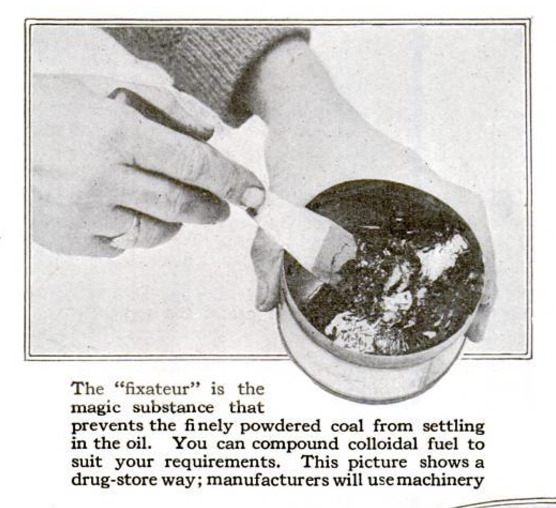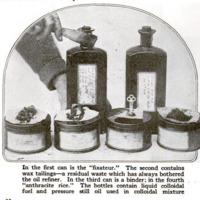-
Title (Dublin Core)
-
The colloidal fuel used to power warships during World War I
-
Article Title and/or Image Caption (Dublin Core)
-
Making a New Fuel to Order. How colloidal fuel helps oil and coal to do more work
-
extracted text (Extract Text)
-
THE mightiest war-ships burn
under their boilers not coal but
oil. In 1917 and 1918 it was so diffi-
cult to obtain oil that for a time it
seemed as if the battleship fleets of
England, France, and Italy would be
unable to perform their task of bottling
up Germany and Austria. The situa:
tion was alarming. The submarine
was literally turning off the spigot of
Europe's oil supply.
In this emergency the engineering
committee of the Submarine Defense
Association of New York, of which
committee Mr. Lindon W. Bates is
chairman, determined to begin a series
of investigations to meet naval de-
mands. An oil expert of inter-
national renown, he decided
that a composite of oil and
finely powdered coal would meet
the demand.
It was not a new idea; but
it had come to naught because
the heavy coal particles always
settled in the oil. Some way
had to be found of holding the
‘minute coal particles in suspen-
sion for a number of months.
When the problem was solved
“colloidal fuel” was created.
Particles that Always Dance
What is a colloid? Chemical
history answers. Between 1861
and 1864 Thomas Graham dis-
covered that, when certain dis-
solved substances are separated
from a surrounding solvent
by a membrane of parchment
or fish-bladder, some of them pass
through the membrane freely into the
surrounding solvent, while others re-
main behind, only to diffuse very
slowly. The particles that do not
pass through are evidently larger than
the pores of the membrane. Graham
called them “colloids.”
Victor Henri, a French scientist who
has done much to explain colloids,
says: “There are no colloids; there
is only a colloidal state, just as there
is a solid state and a liquid state.”
When you blow a puff of cigarette
smoke from your mouth you see a
gaseous colloid of carbon. The finest
ruby-glass is a solid colloid of gold.
In a colloid there is no chemical union
or combination between the particles
held and the medium that holds
them. A current of electricity passed
through a colloid drags the particles
with it.
These particles are always in a state
of violent agitation, dancing about
irregularly because of the collisions
that incessantly take place.
Preventing the Powder from Settling
Colloidal fuel is simply a mixture of
very finely powdered coal, oil, and a
stabilizer (“fixateur,” Mr. Bates calls
it) to prevent the coal particles from
settling in the oil.
The nature of the fixateur is not
disclosed. It
produces a
state in which
the force of
gravity is so
far overcome
that the mix-
ture of coal
and oil remain
permanent for
months. When
settling does
eventually
manifest it-
self, brief stir-
ring is all that
is required to
restore the
fuel to its
previous con-
sistency.
It is possi-
ble to sustain
for months
from thirty to forty per cent of coal |
in oil. Ina colloidal fuel about forty-
five per cent oil, twenty per cent tar,
and thirty-five per cent pulverized
coal can be combined, thus displacing |
more than half of the oil and securing
equal or greater heat values for each
barrel, thereby saving much money.
At least twenty-five per cent of the
fuel oil now burned is conserved and
the world's supply of liquid fuel is
increased by fifty per cent.
Oil refiners have always won-
dered how they could dispose of
their residues profitably. Col-
loidal fuel supplies the answer.
The “Cinderella products of re-
fining,” as Mr. Bates calls them,
can be used to prepare a fuel
that will command a premium
because it is valuable in making
the higher grade alloy steels.
It Can Be Pumped Like Oil
Colloidal fuel gan be com-
pounded like a prescription.
This means that the particular
kind of fuel best suited for a
particular plant can be made by
a central laboratory. One com-
posite in the range of ordinary
temperatures is composed of
about half coal and half oil. Another
unctuous semi-liquid is nearly three
fourths coal and one fourth oil. The
more coal that is added the more
paste-like the fuel becomes. But all
the pastes are mobile up to sixty per
cent coal, and are pumped and atom-
ized as if they were liquid. With the
liquid grades the oil-burning equip-
ment of a vessel or a plant need not
be changed.
At sea astonishing results
have been secured. The
net saving of oil on the |
research vessel with which |
the Submarine Defense |
Association experimented
amounted to twenty-seven
per cent. Moreover, with |
the same tank or bunker
space a longer cruising
radius without refueling is
obtained. A war-ship ora
merchant-ship can increase
its steaming radius up to
twenty-five per cent.
Cost Savings
The savings of cost in- |
volved in the use of col-
loidal fuel are remarkable.
An industrial company in
Ohio burns three hundred
‘bushels of oil per day; its oil
costs seven cents a gallon;
its coal five dollars a ton.
A saving of fifty-five cents a barrel,
or one hundred and sixty-five dol-
lars a day, is effected by the use of
colloidal fuel, quite apart from con-
sidering the conservation of oil and the
reduction of transport.
Oil is now extensively used in
furnaces of various kinds—brick-kilns,
annealing plants, blacksmith shops,
brass foundries, and steel works.
About seventy per cent of the oil
burned by these furnaces can be made
to do the present duty of one hun-
dred per cent, and more cheaply at
that.
A certain steel plant uses three
thousand barrels of oil daily, and soon
it will require four thousand five hun-
dred barrels. But the three thousand
barrels of oil with coal incorporated
and used as colloidal fuel will be
ample for the full output, thus effect-
ing a saving of about five hundred
thousand barrels a year.
In industrial plants many millions
of barrels of oil ere consumed annu-
ally. If only twenty-five per cent of
this oil were displaced by fluidized
coal great savings would result. Three
million barrels of oil em-
ployed in colloidal fuel
could do the work of over
four million straight barrels.
The oil reservoirs of the
world are being drained to
their very dregs. We must
conserve oil, but not at the
expense of industry.
Using Low-Grade Coal
Colloidal fuel opens the
doors wide to let the world
have from the stills all the
assistance it needs without
starving hungry boilers or
flaming furnaces of the
grosser fluid fuels which
constitute their food.
Moreover, great deposits
of low-grade coal, as well
as large quantities of
lignites, brown coals, and
waste dusts, are added to
the world’s fuel supplies.
The world is familiar with
three kinds of fuel—solid (coal), liquid
(oil); and gas. We now have a fourth |
fuel which promises to become of
world-wide importance. |
-
Contributor (Dublin Core)
-
Walter Bannard (writer)
-
Language (Dublin Core)
-
eng
-
Date Issued (Dublin Core)
-
1919-07
-
pages (Bibliographic Ontology)
-
66-67
-
Rights (Dublin Core)
-
Public domain (Google digitized)
-
Archived by (Dublin Core)
-
Davide Donà
-
Alberto Bordignon (Supervisor)
 Popular Science Monthly, v. 95, n. 1, 1919
Popular Science Monthly, v. 95, n. 1, 1919








